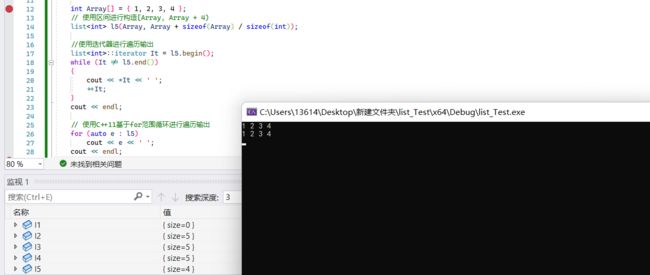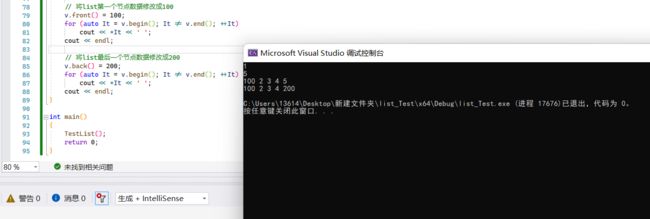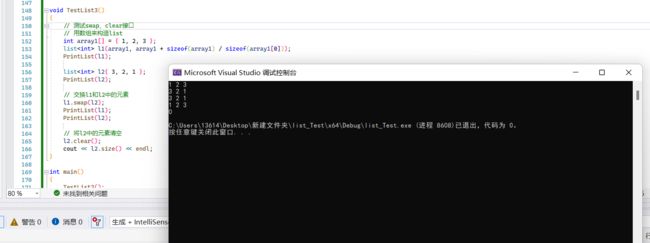C++STL之<list>
目录
- 前言
-
- list
- 1、list的介绍及使用
-
- 1.1、list的介绍
- 1.2、list的使用
-
- 1.2.1、list容器常见的构造函数
- 1.2.2、list iterator(迭代器的使用)
- 1.2.3、list capacity
- 1.2.4、list element access
- 1.2.5、list modifiers
- 1.2.5、list迭代器失效问题
- 2、list模拟实现
-
- 2.1、模拟实现list(vs2022)
- 2.2、对mylist接口进行测试
- 3、list与vector的对比
前言
本篇文章进行STL中list(双向链表)序列容器的学习!!!
list
1、list的介绍及使用
1.1、list的介绍
【list的文档介绍】
- list是可以在常数范围内在任意位置进行插入和删除的序列容器,并且该容器可以前后双向迭代
- list的底层是双向链表结构,双向链表中每个元素存储在互不关联的独立节点中,在节点中听过指针指向其前一个元素和后一个元素来进行链接
- list与forward_list非常相似:最主要的不同在于forward_list是单链表,只能往前进行迭代,已让其简单高效,而list可以往前和往后进行迭代
- list与其他容器相比(array、vector、deque),list通常在任意位置进行插入、移除元素的执行效率更好,尾插尾删效率慢,需要迭代一遍
- list与其他序列容器相比,list和forward_list最大的缺陷是不支持任意位置的访问
比如:
- 要访问list的第n个元素,必须从已知的位置(头结点或尾节点)迭代到该位置,在这段位置上迭代需要线性时间的开销
- list还需要一些额外的空间,以保持每个节点的相关信息(对于存储类型较小元素的大list来说这可能是一个重要的因素)
1.2、list的使用
list中的接口比较多,此处类似,只需要掌握如何正确的使用,然后再去深入研究背后的原理,已达到可扩展的能力。以下为list中一些常见的重要接口
1.2.1、list容器常见的构造函数
| (constructor)构造函数 | 接口说明 |
|---|---|
| list() (重点) | 构造空的list |
| list(size_type n, const value_type& val = value_type()) | 构造list中包含n个值尾val的元素 |
| list (const listr& l) (重点) | 拷贝构造函数 |
| list (InputIterator first, InputIterator last) | 使用区间[first, last)中的元素来构造list |
举个栗子:
void TestList()
{
list<int> l1; // 构造空的list
list<int> l2(5, 100); // 构造5个值为100的list
list<int> l3(l2); // 拷贝构造函数
list<int> l4(l3.begin(), l3.end()); // 使用迭代器来构造list
int Array[] = { 1, 2, 3, 4 };
// 以数组为迭代器区间来构造list[Array, Array + 4)
list<int> l5(Array, Array + sizeof(Array) / sizeof(int));
// 使用迭代器进行遍历输出
list<int>::iterator It = l5.begin();
while (It != l5.end())
{
cout << *It << ' ';
++It;
}
cout << endl;
// 使用C++11基于for范围循环进行遍历输出
for (auto e : l5)
cout << e << ' ';
cout << endl;
}
1.2.2、list iterator(迭代器的使用)
| 函数声明 | 接口说明 |
|---|---|
| begin + end | 返回第一个元素的迭代器 + 返回最后一个元素的下一个位置的迭代器 |
| rbegin + rend | 返回第一个元素的reverse_iterator,即end位置,返回最后一个元素下一个位置的reserve_iterator,及begin位置 |
【注意】
- begin与end为正向迭代器,对迭代器执行++操作,迭代器向后移动
- rbegin(end)与rend(begin)为反向迭代器,对迭代器执行++操作,迭代器向前移动
举个栗子:
void print_list(const list<int>& l)
{
// 注意这里调用的是list的 begin()const,返回list的常量迭代器
for (list<int>::const_iterator it = l.begin(); it != l.end(); ++it)
{
cout << *it << " ";
// *it = 10; // 编译不通过 --- 被const修饰不能修改
}
cout << endl;
}
int main()
{
int array[] = { 1, 2, 3, 4, 5, 6, 7, 8, 9, 0 };
list<int> l(array, array + sizeof(array) / sizeof(array[0]));
// 使用正向迭代器正向list中的元素
for (list<int>::iterator it = l.begin(); it != l.end(); ++it)
cout << *it << " ";
cout << endl;
// 使用反向迭代器逆向打印list中的元素
for (list<int>::reverse_iterator it = l.rbegin(); it != l.rend(); ++it)
cout << *it << " ";
cout << endl;
return 0;
}
1.2.3、list capacity
| 函数声明 | 接口说明 |
|---|---|
| empty | 检测list是否为空,是返回true,否返回false |
| size | 返回list节点的有效个数 |
举个栗子:
void TestListCapacity()
{
list<int> v1;
list<int> v2{ 1, 2, 3, 4 };
cout << "v1的有效节点个数为: " << v1.size() << '\t'
<< "v1是否为空: " << v1.empty() << endl;
cout << "v2的有效节点个数为: " << v2.size() << '\t'
<< "v是否为空: " << v2.empty() << endl;
}
int main()
{
TestListCapacity();
return 0;
}
1.2.4、list element access
| 函数声明 | 接口说明 |
|---|---|
| front | 返回list第一个节点中值(val)的引用 |
| back | 返回list最后一个节点中值(val)的引用 |
举个栗子:
void TestList()
{
list<int> v{ 1, 2, 3, 4, 5 };
// 输出list中第一个节点的数据
cout << v.front() << endl;
// 输出list中最后一个节点的数据
cout << v.back() << endl;
// 将list第一个节点数据修改成100
v.front() = 100;
for (auto It = v.begin(); It != v.end(); ++It)
cout << *It << ' ';
cout << endl;
// 将list最后一个节点数据修改成200
v.back() = 200;
for (auto It = v.begin(); It != v.end(); ++It)
cout << *It << ' ';
cout << endl;
}
int main()
{
TestList();
return 0;
}
1.2.5、list modifiers
| 函数声明 | 接口说明 |
|---|---|
| push_back | 在list尾部插入值为val的元素 |
| pop_back | 删除list中最后一个元素 |
| push_front | 在list首元素前插入值为val的元素 |
| pop_front | 删除list中第一个元素 |
| insert | 在list position位置前插入值为val的元素 |
| erase | 删除list position位置的元素 |
| swap | 交换二个list中的元素 |
| clear | 清空list中的有效元素 |
举个栗子1️⃣:
void PrintList(list<int>& l)
{
for (auto& e : l)
cout << e << " ";
cout << endl;
}
void TestList1()
{
// 测试push_back、pop_back、pusk_front、pop_front
int array[] = { 1, 2, 3 };
list<int> L(array, array + sizeof(array) / sizeof(array[0]));
// 在list的尾部插入4,头部插入0
L.push_back(4);
L.push_front(0);
PrintList(L);
// 删除list尾部节点和头部节点
L.pop_back();
L.pop_front();
PrintList(L);
}
举个栗子2️⃣:
// 测试insert、erase接口
void TestList2()
{
int Array1[] = { 1, 2, 3 };
list<int> L(Array1, Array1 + sizeof(Array1) / sizeof(Array1[0]));
// 获取list中第二个节点
auto pos = ++L.begin();
cout << *pos << endl;
// 在pos前插入值为4的元素
L.insert(pos, 4);
PrintList(L);
// 在pos前插入5个值为5的元素
L.insert(pos, 5, 5);
PrintList(L);
// 在pos前插入[v.begin(), v.end)区间中的元素
vector<int> v{ 7, 8, 9 };
L.insert(pos, v.begin(), v.end());
PrintList(L);
// 删除pos位置上的元素
L.erase(pos);
PrintList(L);
// 删除list中[begin, end)区间中的元素,即删除list中的所有元素
L.erase(L.begin(), L.end());
PrintList(L);
}
举个栗子3️⃣:
void PrintList(list<int>& l)
{
for (auto& e : l)
cout << e << " ";
cout << endl;
}
void TestList3()
{
// 测试swap、clear接口
// 用数组来构造list
int array1[] = { 1, 2, 3 };
list<int> l1(array1, array1 + sizeof(array1) / sizeof(array1[0]));
PrintList(l1);
list<int> l2{ 3, 2, 1 };
PrintList(l2);
// 交换l1和l2中的元素
l1.swap(l2);
PrintList(l1);
PrintList(l2);
// 将l2中的元素清空
l2.clear();
cout << l2.size() << endl;
}
1.2.5、list迭代器失效问题
迭代器失效:
- 可以将迭代器暂时理解成原生态指针,迭代器失效即所指向的节点已被销毁或释放,即该节点被删除了。
- list的底层结构为双向链表,因此在list中进行插入时,是不会导致list迭代器失效的(list底层存储空间不连续)
- 只有在删除节点时才会失效,并且失效的指针指向被删除节点的迭代器,其他迭代器不受影响
举个栗子:
// 错误写法
void TestListIterator1()
{
int Array[] = { 1, 2, 3, 4, 5, 6, 7, 8, 9, 10 };
list<int> l(Array, Array + sizeof(Array) / sizeof(int));
auto It = l.begin();
while (It != l.end())
{
// erase()接口被执行后,It所指向的节点已被删除,导致It迭代器无效,在下一次使用时,必须重新赋值
l.erase(It);
++It;
}
}
// 正确写法
void TestListIterator2()
{
int Array[] = { 1, 2, 3, 4, 5, 6, 7, 8, 9, 10 };
list<int> l(Array, Array + sizeof(Array) / sizeof(int));
auto It = l.begin();
while (It != l.end())
{
// erase()接口被执行后,对It重新赋值
l.erase(It++); // It = l.erase(It) -- 后置++先使用后自增
}
}
2、list模拟实现
2.1、模拟实现list(vs2022)
list.h
#ifndef LIST_H_
#define LIST_H_
#include "reverse_iterator.h"
#include reverse_iterator;
//typedef Reverse_Iterator const_reverse_iterator;
reverse_iterator rbegin() { return reverse_iterator(end()); }
reverse_iterator rend() { return reverse_iterator(begin()); }
const reverse_iterator crbegin() const { return const_reverse_iterator(end()); }
const reverse_iterator crend() const { return const_reverse_iterator(begin()); }
//========================== constructor =====================================
list() { empty_init(); }
list(const list& l)
{
empty_init();
// 用l中的元素构造临时的temp, 然后与当前对象交换(复用区间构造函数进行拷贝构造)
list<T> tmp(l.cbegin(), l.cend());
this->swap(tmp);
}
list<T>& operator=(list<T> l)
{
this->swap(l);
return *this;
}
list(int n, const T& value = T())
{
empty_init();
while (n--)
push_back(value);
}
template <typename InputIterator>
list(InputIterator first, InputIterator last)
{
empty_init();
while (first != last)
{
push_back(*first);
++first;
}
}
~list()
{
if (pNode != nullptr)
{
this->clear();
delete pNode;
pNode = nullptr;
}
}
//========================== Node insertion and deletion =============================
void push_back(const T& val) { insert(pNode, val); }
void pop_back() { erase(pNode->pre); }
void push_front(const T& val) { insert(pNode->next, val); }
void pop_front() { erase(pNode->next); }
iterator insert(iterator pos, const T& val)
{
PNode newNode = new Node(val);
PNode pCur = pos._PNode;
PNode posPre = pCur->pre;
newNode->next = pCur;
pCur->pre = newNode;
posPre->next = newNode;
newNode->pre = posPre;
return pos;
}
iterator erase(iterator pos)
{
// 删除哨兵位头节点会崩溃
assert(pos != end());
PNode cur = pNode->next;
PNode posNext = pos._PNode->next;
PNode posPre = pos._PNode->pre;
posPre->next = posNext;
posNext->pre = posPre;
delete pos._PNode;
// 删除pos节点后,导致迭代器失效,返回pos节点的下一个节点做为新的迭代器
return iterator(posNext);
}
size_t size() const
{
PNode pCur = pNode->next;
size_t Size = 0;
while (pCur != pNode)
{
++Size;
pCur = pCur->next;
}
return Size;
}
size_t capacity() const { return this->size(); }
//======================= Head and tail data access ==================================
T& front() { return pNode->next->date; }
const T& front()const { return pNode->next->date; }
T& back() { return pNode->pre->date; }
const T& back()const { return pNode->pre->date; }
//========================== Auxiliary interface =====================================
void empty_init()
{
// 构造头节点,带头双向循环链表一开始指向自己
pNode = new Node;
pNode->next = pNode;
pNode->pre = pNode;
}
void swap(list& l)
{
std::swap(pNode, l.pNode);
}
iterator find(const T& val)
{
auto it = begin();
while (it != pNode)
{
auto it = begin();
while (it != end())
{
if (*it == val)
return iterator(it);
++it;
}
}
return iterator(end());
}
void clear()
{
auto it = begin();
while (it != end())
{
it = erase(begin());
}
pNode->next = pNode;
pNode->pre = pNode;
}
private:
PNode pNode;
};
}
#endif
reverse_iterator.h
- 这里的反向迭代器实现使用是迭代器萃取技术,需要对模板特化的技术的了解,可以省略
#ifndef REVERSE_ITERATIR_H_
#define REVERSE_ITERATIR_H_
namespace mylist
{
template <typename Iterator>
struct Iterator_traits
{
typedef typename Iterator::reference reference;
typedef typename Iterator::pointer pointer;
};
template <typename T>
struct Iterator_traits<T*>
{
typedef T& reference;
typedef T* pointer;
};
template <typename T>
struct Iterator_traits<const T*>
{
typedef const T& reference;
typedef const T* pointer;
};
template <typename Iterator>
struct Reverse_Iterator
{
typedef typename Iterator_traits<Iterator>::reference reference;
typedef typename Iterator_traits<Iterator>::pointer pointer;
public:
typedef Reverse_Iterator<Iterator> self;
public:
//========================== constructe =====r=============================
Reverse_Iterator(Iterator It = Iterator())
: _It(It)
{}
Reverse_Iterator(const self& rit)
: _It(rit._It)
{}
//========================== operator =====================================
reference operator*()
{
Iterator tmp(_It);
return *(--tmp);
}
pointer operator->()
{
return &(this->operator*());
}
//========================== operator =====================================
self& operator++()
{
--_It;
return *this;
}
self operator++(int)
{
Reverse_Iterator tmp(*this);
--_It;
return tmp;
}
self& operator--()
{
++_It;
return *this;
}
self operator--(int)
{
Reverse_Iterator tmp(*this);
++_It;
return tmp;
}
bool operator!=(const self& s) { return _It != s._It; }
bool operator==(const self& s) { return _It == s._It; }
//========================== 成员数据 =====================================
public:
Iterator _It;
};
}
#endif
2.2、对mylist接口进行测试
#include "list.hpp"
// 正向打印list
template <typename T>
void Printlist(mylist::list<T>& l)
{
auto It = l.cbegin();
while (It != l.cend())
{
cout << *It << ' ';
++It;
}
cout << endl;
}
// 测试list构造
void Test_list_constructor()
{
mylist::list<int> l1;
mylist::list<int> l2(10, 5);
Printlist<int>(l2);
int Array[] = { 1, 2, 3, 4, 5, 6, 7, 8, 9, 0 };
mylist::list<int> l3(Array, Array + sizeof(Array) / sizeof(int));
Printlist(l3);
mylist::list<int> l4(l3);
Printlist(l4);
l1 = l4;
Printlist(l1);
}
// 测试pusk_back、pop_back、pusk_front、pop_front
void Testlist2()
{
// 测试push_back、pop_back
mylist::list<int> l;
for (int i = 0; i < 5; ++i)
l.push_back(i);
Printlist(l);
for (int i = 0; i < 5; ++i)
l.pop_back();
cout << l.size() << endl;
// 测试pusk_front、pop_front
for (int i = 0; i < 5; ++i)
l.push_front(i);
Printlist(l);
for (int i = 0; i < 5; ++i)
l.pop_front();
cout << l.size() << endl;
}
void Testlist3()
{
int array[] = { 1, 2, 3, 4, 5 };
mylist::list<int> l(array, array + sizeof(array) / sizeof(array[0]));
auto pos = l.begin();
l.insert(l.begin(), 0);
Printlist(l);
++pos;
l.insert(pos, 2);
Printlist(l);
l.erase(l.begin());
l.erase(pos);
Printlist(l);
// pos指向的节点已经被删除,pos迭代器失效
cout << *pos << endl;
auto it = l.begin();
while (it != l.end())
it = l.erase(it);
cout << l.size() << endl;
}
struct T
{
T(int _a = 0, double _b = 0.0)
: a(_a)
, b(_b)
{}
int a;
double b;
};
void Testlist4()
{
mylist::list<T> l;
l.push_back(T(1, 1.1));
l.push_back(T(2, 2.2));
l.push_back(T(3, 3.3));
for (auto it = l.begin(); it != l.end(); ++it)
// 底层调用原理:it.operator()->->a/b, 下面it->a/b是编译器为了可读性进行了优化(省略了一个->)
cout << it->a << ' ' << it->b << endl;
}
void reverve_iterator()
{
int Array[] = { 1, 2, 3, 4, 5, 6, 7, 8, 9 };
mylist::list<int> l3(Array, Array + sizeof(Array) / sizeof(int));
for (auto rit = l3.rbegin(); rit != l3.rend(); ++rit)
cout << *rit << ' ';
cout << endl;
}
int main()
{
Test_list_constructor();
Testlist2();
Testlist3();
Testlist4();
reverve_iterator();
return 0;
}
3、list与vector的对比
vector与list都是STL中非常重要的序列式容器,由于两个容器的底层结构不同,导致其特性以及应用场景不同,其主要不同如下:
| vector | list | |
|---|---|---|
| 底层结构 | 动态顺序表,一段连续空间 | 带头节点的双向循环链表 |
| 随机访问 | 支持随机访问,访问某个元素效率O(1) | 不支持随机访问,访问某个元素效率O(N) |
| 插入和删除 | 任意位置插入和删除效率低,需要搬移元素,时间复杂度为O(N),插入时可能需要增容。增容:开辟新空间,拷贝元素,释放旧空间,导致效率更低 | 任意位置插入和删除效率高,不需要搬移元素,时间复杂度为O(1),不存在增容问题 |
| 空间利用率 | 底层为连续空间,不容易造成内存碎片,空间利用率高,缓存利用率高 | 底层节点随机动态开辟,小节点容易造成内存碎片,空间利用率低,缓存利用率低 |
| 迭代器 | 原生态指针 | 对原生态指针(节点指针)进行封装 |
| 迭代器失效 | 在插入元素时,要给所有的迭代器重新赋值,因为插入元素有可能会导致重新扩容,致使原来迭代器失效,删除时,当前迭代器需要重新赋值否则会失效 | 插入元素不会导致迭代器失效,删除元素时,只会导致当前迭代器失效,其他迭代器不受影响 |
| 使用场景 | 需要高效存储,支持随机访问,不关心插入删除效率 | 大量插入删除操作,不关心随机访问 |






